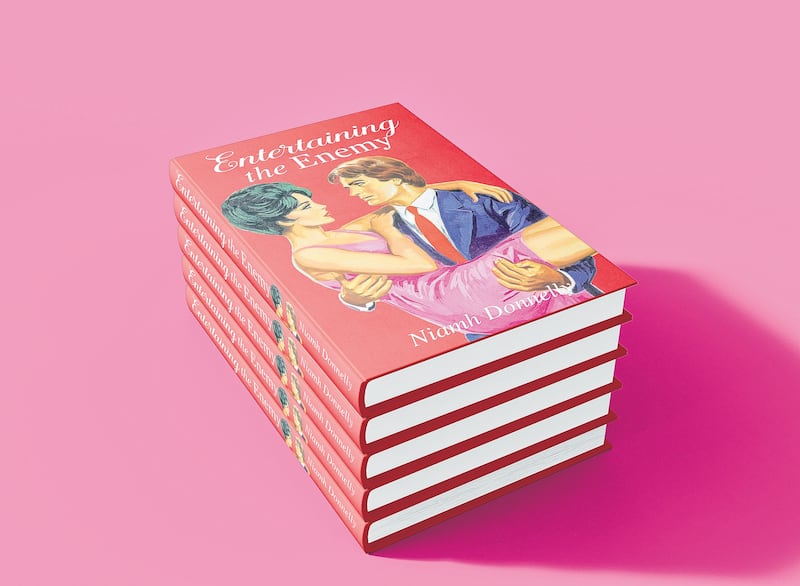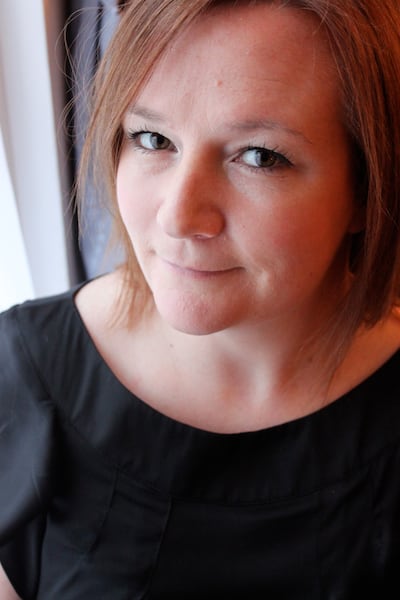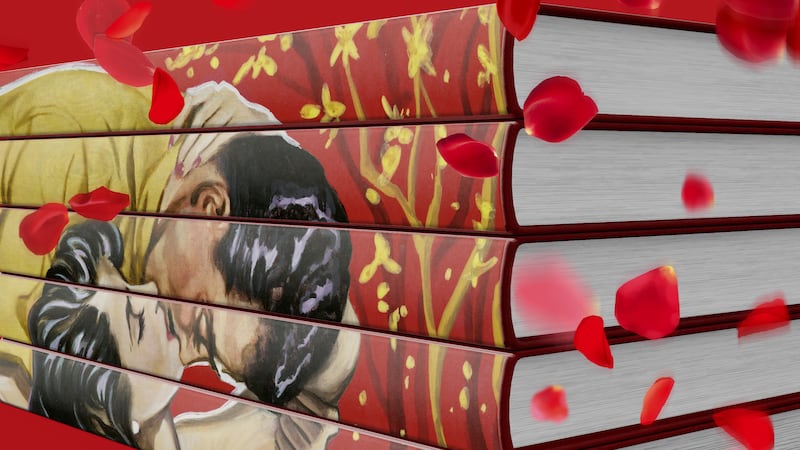They say romance is dead, and they say the novel is dead, but try telling that to fans of the romance novel.
The genre has been wooing readers for generations and in recent years has seen something of a boom. In 2022, the Romance & Sagas category on Nielsen BookScan recorded its best sales in a decade, owing in no small part to an enthusiastic cohort of BookTokers (TikTok bookworms), bringing raunchy reads into the mainstream. It won’t be surprising if this Valentine’s Day, more people enjoy a literary romp than a literal one. But what’s the secret to a good romance novel? Can anyone pen the next great bodice-ripper? This is the question I put to myself one January afternoon, bored, broke and daydreaming of another life.
A short note on my fiction-writing career to date: it has mostly consisted of being rejected by literary journals and failing to write a novel. It’s a happy life – highbrow, literary, irrelevant. But perhaps I could be seduced by the sweet allure of love stories. Writing the next Lovers in the Desert or Billionaire’s Mistress may not have the same cache as writing the next War and Peace, but it might be more realistic. Booker Prize winner John Banville famously made his career writing literary novels for show, crime novels for the dough (I don’t think he used those words exactly). Could the missing link in my own literary life be a lowbrow alter ego?
The most infamous purveyor of page-turning liaisons and salacious love affairs might be Mills & Boon. Founded in 1908, the UK publishing house originally produced etiquette books, socialist tracts and a variety of fiction titles, but in the 1920s, as a means of combating financial ruin, it turned to romance publishing.
READ MORE
As a struggling freelancer, I could do with combating my own financial ruin. And Mills & Boon has a reputation for its democratic submissions policy. The website has a page devoted to aspiring authors, with writing tips and lists outlining the essential elements of a Mills & Boon book. “There is no formula for writing a publishable romance!” the page states, categorically. Nonetheless, each of the six Mills & Boon “series” (Modern, Medical, Historical, Heroes, True Love and Desire) makes “key promises”, upon which authors tend to deliver.
Senior editor Flo Nicoll tells me that the publisher has always welcomed work from unagented writers.

“It’s a big part of the brand. A lot of our authors started out as readers as well.”
I tell her I want to try my hand at romance writing and she agrees to read and critique an excerpt from my work.
I ask if there are any templates to follow, and she reiterates what the website says: there is no formula. There are, however, “expectations of the genre, the most crucial one being that there’s a happy ending. But there’s a million different ways that you can do that.”
Nicoll works for the Mills & Boon Modern series. It’s “the home of the alpha male” and its key promises are high drama, high stakes and lots of wealth and glamour.
“This is where you find the billionaires,” she says. “It’s the most OTT, dramatic series we have. It’s very emotionally intense and sexually intense as well.”
I take out a notebook and pen, fill a hot water bottle and curl up on the couch. Already, I’ve started to imagine myself as someone who wears oversized knits, takes bubble baths and, behind an innocent, Elizabeth-Arden-softened face, is secretly penning filthy vignettes for the masses.
I decide to make my hero a multi-hyphenate multimillionaire.
He must “command and seduce”, the guidelines say. “There’s nothing in the world his powerful authority and money can’t buy.” I make him a business-magnate-slash-podcaster who has everything but needs a smart woman to bolster his image and help his podcast reach a new demographic.
The heroine, meanwhile, mustn’t be afraid to stand up to the hero, “whether she’s at home in his opulent world or not”. I make mine a penniless PhD student with a part-time catering job. She’s vehemently against the hero’s excessive lifestyle. I devise a “meet cute” in which the heroine serves drinks to the hero and ends up criticising his immodest lifestyle.
My plan is to develop a frisson that will be sustained throughout the narrative. The chemistry between the pair will pull them together, but their clashing principles will push them apart. Eventually they’ll overcome their differences and fall in love. In between, there’ll be lots of jet setting – Modern Romance stories have “glitzy, glamorous, international settings to upstage even the swankiest of red-carpet premieres” – and, of course, plenty of hot sex.
I call it Entertaining the Enemy. It’s no best-seller, but I feel I’ve ticked the boxes. It’s a Cinderella story – lowly maiden seduced by rich prince.
I’m not yet confident enough to write a full-blown sex scene, but I include as many physical descriptions and sensations as I can stomach.
“He wore a suit that was tailored to perfection, lapels skimming his broad torso,” I write. “The top of his shirt was buttonless, opening on to a dark, slightly stubbled neck. His voice, low and steady, had undeniable authority.”
The hero, a beefed-up bro, is not my cup of tea, but he’s the kind of commercially attractive and authoritative figure I think I’m supposed to write.
The heroine seems to be beset by a physical lack of control in his presence, something that might be a little strange in real life, but seems to fit the romantic fiction bill.

“She felt a wave of something pass through her as she stood before him, her skin growing warm and sensitive.”
In some ways, writing this excerpt is freeing. I’m not afraid to be a little over the top, and I don’t tie myself in knots in service of (booming voice) “the sentence”. But there’s something unsettling about it, too. I’m writing to a type. My heroine is independent and strong-willed, but only superficially. She will always defer to the alpha in the end. And my hero is, well, kind of an a**hole.
I pepper the text with suggestive words and phrases. “Moist”, I write. “Throbbed”. “Insatiable thirst”. But there’s no real flair to the language, no ingenuity to the structure. My purpose is to satisfy and titillate, and while this may no longer be considered a morally depraved endeavour, it feels like an artistically empty one.
I wonder if romance writing is fundamentally flawed. Does it perpetuate gender stereotypes? Can the sexual imagination be a creatively fertile place? Or is it a sad, seedy bedroom, wallpapered with cliche?
Daisy Cummins is an Irish author who, under the pseudonym of Abby Green, has written over 60 Mills & Boon novels. She is also the daughter of the late feminist Irish Times journalist Mary Cummins.
“What [Daisy] doesn’t know about writing for M&B isn’t worth knowing,” Nicoll tells me.
What she does know is that writing a Mills & Boon novel is far more complex than it seems.
“It’s not easy to sit down and thrash out 50,000 words,” Cummins says. “If you’re doing a good job, you’re building a character that has motivation, and conflict, and a past and a future, and desires. You’re not constructing something that is conforming to a stereotype.”
When I write a couple who are supposed to be destined for one another, I feel so cynical towards them I sabotage that destiny
Nicoll agrees that if you’re writing to stereotype or cliche, you’re doing it wrong. The way to avoid this, she says, is to give your characters believable internal motivators, and fully fleshed out backstories.
“We often joke that [Mills & Boon] has a very high body count”, she laughs. This is because giving a character a “real trauma” in their past also gives them “a very clear journey to go on”. But if you’re a parent to a Mills & Boon hero or heroine, good luck.

Internal motivation and conflict might be the hallmark of a good story. But what about the thing that, for many, defines a Mills & Boon novel: sex. How do you write that without being cliched or cringey?
“The biggest thing to avoid is sex for the sake of it,” Nicoll says. “That, ultimately, is not very interesting. Sex scenes always need to drive the story forward.”
Cummins points out that not all Mills & Boon novels have sex in them.
“You don’t have to do a sex scene. It really depends on the author and how much they’re comfortable with or how much they want to do it. I don’t mind being a little bit explicit. Other authors like to close the door so you don’t really see that.”
For Cummins, writing sex comes naturally. “I don’t know what that says about me, but I don’t find it an issue. When I was a teenager, I was binge-reading Judith Krantz and Jackie Collins, so I probably got an education early on into reading and writing sex.”
The sex scenes in an Abby Green novel are “very character driven. And because [Modern Romance] books are only 50,000 words, it’s very tight. The sex scene has to move the story along.”
Not only does Cummins achieve a lot in a short word count, she also achieves a lot in a short amount of time. It takes her about two to three months to write a novel, and she usually releases multiple books a year.
“If I’m on a good streak, I would probably be writing about 2,000 words a day. For me, it’s a full-time job. It’s all that I do. So, I have to make it my full-time focus.”
Meanwhile, my delusions about earning a fortune as a romance author might be just that. Cummins, who has been publishing novels for almost two decades is “making enough of a living to live [but] I’m not living in Dalkey, put it that way”.
“I would say, and this was always said to me when I was starting out, do not give up your day job.”
One of her fellow Mills & Boon authors works as an NHS nurse.
“She’s a very fast writer. She’ll take 20 minutes out of her lunch break and sit down and try to do as many words as she can. And then she obviously works when she goes home, or when she has days off, or whatever.”
The bulk of Mills & Boon readers are women between the ages of 25 and 44. They’re “hugely sophisticated and absolutely voracious”, Cummins says.
“I think people kind of underestimate how huge romance is. There’s obviously some derision pointed at romance, but it’s really grown and there’s a lot of male-on-male, there’s a lot of LGBTQ romances out there now. So, it’s an incredibly inclusive space. It’s very diverse.”
It seems like an impossible paradox, though it’s one faced by all fiction writers: to tell the truth in a lie
Nicoll says that there are still lots of misconceptions around romance novels.
“I think probably the most frequent one – although I hope that this is fading out – is that they’re really old fashioned, or for your grandma. Or that they’re really sexist. In my experience, they track the evolving, changing social dynamic really closely, because they have to. And they’re written by women who are living and breathing themselves.”
One thing that’s helping the genre shed its old-fashioned cobwebs is enthusiasm on BookTok. The #spicybooks hashtag (signalling books that are risqué or sexually explicit) has 937,000 views and counting. Users will rate their most titillating titles using chilli pepper emojis.
Nicoll says it’s exciting to see “a generation of romance readers who are really loud and proud of what they love to read and being really vocal about it”. But she points out that there’s nothing new under the romance sun.
“Because of the volume of titles we publish, it’s quite rare that something is blowing up on BookTok and we don’t already have an example of it in our catalogue.” Phrases like “grumpy sunshine” (the genre where one character has a sunny personality and the other is downbeat) might not have been in circulation five years ago, but TikTokers didn’t invent the “opposites attract” trope.

More generally, the breadth of work on offer under the romance umbrella is incredibly wide. Cummins draws my attention to a series involving love affairs between humans and blue aliens.
The aliens “have attributes”, she tells me, tactfully.
I hadn’t heard of it, but Ice Planet Barbarians is a huge BookTok sensation, with dozens of titles, populated with well-endowed blue creatures.
“I can’t tell you how popular it is,” Cummins says. “So, literally anything that you want in a romance, it’s being done.”
As for my own, non-alien characters, the feedback is ... also tactful. Nicoll tells me that Entertaining the Enemy is an “accessible”, “easy to get into”, enemies-to-lovers storyline.
Reading between the lines, however, it’s clear that my characters aren’t enemies to lovers. They’re just enemies.
“What you don’t want is for people to be like ‘these two shouldn’t be together’,” Nicoll advises.
Oops.
Reading back, it’s true. My hostility towards the work has bled through. There isn’t enough inner conflict or backstory. The characters are stereotypes because I made them stereotypes.
“She hated his brand of bro-targeted ministrations, hated his conventional tastes, his excessive lifestyle,” I write, thinking I’m composing a cutesy dynamic. “In his podcast, and on social media, he preached about how easy it was to get rich. He liked to maintain a perfect six-pack and judged those who couldn’t do the same.” The fact is, my version of an alpha is just an ass.
Still, I’m not convinced that given the feedback, I could go back and do it any better. Romance writing, Cummins and Nicoll tell me, is entertainment – escapism. It’s a fantasy that smooths over the irritants of the everyday – the washing-up, the taking the kids to creche. This is literature to be read in hospital waiting rooms or after a bad break up. It’s not supposed to represent real life. And at the same time, the characters must be undeniably authentic.
It seems like an impossible paradox, though it’s one faced by all fiction writers: to tell the truth in a lie. Indeed, when you look closely, it’s hard to tell the difference between genre fiction and any other fiction. Sure, there’s a seemingly limiting set of rules and tropes associated with the likes of romance writing, but all artists conform to rules of some kind, be they rules of grammar, narrative, form or otherwise.

Nonetheless, when it comes to navigating the tightrope of a love story that has conflict, plausible characters and a happy ending, I can’t seem to pull it off. When I write a billionaire, I inadvertently infuse my distaste for the very idea of billionaires. When I write a couple who are supposed to be destined for one another, I feel so cynical towards them I sabotage that destiny. If this is the part of the article where I’m supposed to have my own enemies-to-lovers turning point and fall for romance writing, I’m afraid I must disappoint.
For those who think they are cut out for the task, Nicoll and Cummins have matching advice: read lots of romance.
“I think reading really widely within the genre, whether it’s Mills & Boon or another publisher, helps you understand what’s out there and how you can offer something unique,” says Nicoll.
Cummins says that “what the editors are going to be looking for is a fresh take on what’s being done. Which is the hardest thing to do.”
She’s also convinced that not everybody is suited to romance writing.
“I think you either have a voice for it, or you don’t. Helen Fielding famously tried to write for Mills & Boon and got rejected. And that’s obviously not because she wasn’t a good writer, but because she wasn’t doing what they wanted her to do.”
My own paltry attempt will never see the light of day, nor am I likely to write the next Bridget Jones. Still, all’s fair in love and literature. My quaint aspirations dashed, I’ll skulk back to the cold halls of literary fiction, kneel at the altar of the sentence, and beg forgiveness for ever having been tempted by the romantic notion of romance.



















